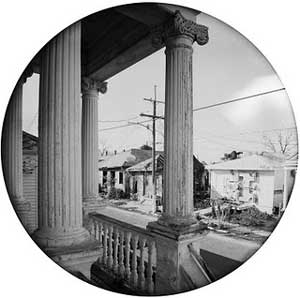By Doug McCash, The Times Picayune
WHEELS OF MISFORTUNE

Tooth for an Eye, Disarchive#: 06-16
New Orleans photographer Deborah Luster searched newspaper archives for the locations of murders. They weren’t hard to find in the Crescent City, one of the country’s killing capitals.
With a cumbersome camera that produces odd, old-fashioned circular photos, Luster documented the weedy lots between blighted buildings, out-of-the-way roadsides and miserable hotels where people violently lost their lives.
Ordinarily, she said, the forlorn places don’t have any particular effect on her. Occasionally, however, they have a difficult-to-describe power. “Sometimes I go to a spot and they’re very hot, very disturbing, ” she said. “I don’t know what it is, some kind of energy or something there.
Like anyone else might, Luster sometimes experienced unexpected chills. When she was a child, her mother would say that someone was walking on her grave. In 1988, Luster’s mother was murdered. Until the killer was caught, Luster suffered spasms of anxiety. After the murderer was convicted, her anxiety seems to have morphed into strangely cathartic creativity.
In the years just before and after the millennium, Luster produced 25,000 photo portraits of inmates, including those at the Louisiana State Penitentiary at Angola. Her small, black and white portraits, often printed on tin, appeared to be 19th-century antiques. The project, titled “One Big Self, ” suggested that things hadn’t changed much in Bayou State prisons for a century. It may seem counterintuitive, Luster said, but the prison project that put her in contact with violent criminals provided “a great deal of release.”
In June, she began documenting murder sites, creating a sort of visual map. To her, the project titled “A Tooth for an Eye: A Chorography of Violence in Orleans Parish, ” is a “bookend” to her prison project, but “much more unsettling.” Once, she said, the sensation of photographing an empty murder site on Florida Avenue was so irrationally creepy that she stayed long enough for one exposure, then threw the camera in the car and fled. Despite such episodes, Luster’s round black and white photos are anything but dramatic. She concentrated on capturing a gray void at the center of the scenes. Quoting from “Moby Dick, ” she calls it the “dumb blankness, full of meaning.” Occasionally the blank space contains poignant touches, such as graffiti that reads “I miss you dad.”
Now and then, Luster encountered savage details such as machine-gun bullet holes perforating the wall of a FEMA trailer. A few photos have a macabre poetry, such as Luster’s haunting shot of the sky with a few passing clouds — the victim, she explained, died on his back. The roundness of Luster’s images contributes to their unnerving intensity. Every line and angle is cycled back from the edges to the bull’s eye center of the composition. To Luster, the roundness relates to the carnival wheels of fortune she collects.
“They stop on the lucky number or color, ” she said, “or the unlucky one.”
Indeed.
Prospect.1 New Orleans is by and large a celebration of the rebirth of this city after the 2005 storm and flood. We welcome the optimism of most of the artists and the economic impact of art tourism. Luster’s work tosses a little cold water into our faces. Like it or not, she points out that many of the problems that preceded the flood persist.
